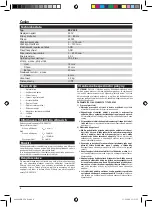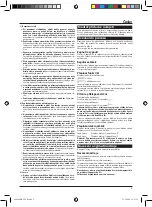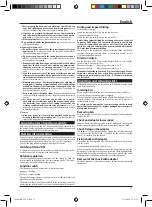
English
11
f)
Dress properly. Do not wear loose clothing or jewellery. Keep
your hair, clothing and gloves away from moving parts.
Loose
clothes, jewellery or long hair can be caught in moving parts.
g)
If devices are provided for the connection of dust extraction
and collection facilities, ensure these are connected and prop-
erly used.
Use of these devices can reduce dust-related hazards.
h)
Wear ear protectors.
Exposure to noise can cause hearing loss.
i)
Usse auxiliary handles supplied with the tool.
Loss of control can
cause personal injury.
4) Power tool use and care
a)
Do not force the power tool. Use the correct power tool for your
application.
The correct power tool will do the job better and safer at
the rate for which it was designed.
b)
Do not use the power tool if the switch does not turn it on and
off.
Any power tool that cannot be controlled with the switch is dan-
gerous and must be repaired.
c)
Disconnect the plug from the power sourc e and/or the battery
pack from the power tool before making any adjustments,
changing accessories, or storing power tools.
Such preventive
safety measures reduce the risk of starting the power tool acciden-
tally.
d)
Store idle power tools out of the reach of children and do not
allow persons unfamiliar with the power tool or these instruc-
tions to operate the power tool.
Power tools are dangerous in the
hands of untrained users.
e)
Maintain power tools . Check for misalignment or binding of
moving parts , breakage of parts and any other condition that
may affect the power tools operation. If damaged, have the
power tool repaired before use.
Many accidents are caused by
poorly maintained power tools.
f)
Keep cutting tools sharp and clean.
Properly maintained cutting
tools with sharp cutting edges are less likely to bind and are easier to
control.
g)
Use the power tool, accessories and tool bits etc. in accord-
ance with these instructions and in the manner intended for
the particular type of power tool, taking into account the
working conditions and the work to be performed.
Use of the
power tool for operations different from those intended could result in
a hazardous situation.
5) Service
a)
Have your power tool serviced by a qualified repair person
using only identical replacement parts.
This will ensure that the
safety of the power tool is maintained.
Supplementary handle assembly
Before any interference to the tool, disconnect the supply cable first. Use
the hammer only with supplementary handle (10). Mount the handle to
the fastening neck and secure with revolving grip.
Putting into operation
Connect only to a single-phase alternating current power network with
voltage marked on the nameplate. It is possible to connect the tool even
to outlets without a protective contact, as this is a class II appliance.
Check, if the plug type corresponds with type of the outlet.
Switching ON and OFF
To switch the tool on, push the switch (4) and hold. The hammer switch-
es off as soon as you release the hold of the switch.
Rotation regulation
You can continuously change rotations with the switch (5). Push the
switch slightly and the hammer will start rotating slowly. The stroger
you push at the switch, the faster the rotation.
Function switch
The change-over switch of functions (6) has two positions:
= drilling,
= impact drilling.
Change the functions in the rest position only. Swivel the switch (6) sim-
ply to the requested position.
The hammer drill gearbox will be switched to the selected position after
depressing the switch (4) and/or as soon as the hammer drill is started.
Drilling and impact drilling
For drilling or screwing:
switch the function switch (6) onto the symbol
.
If you want impact drilling:
switch the function switch (6) onto the symbol
.
Notice: When impact drilling, do not change the speed to the left
to prevent drill damage. You can switch the speed to the left only
if the drill is jammed and you want to put it out of the hole more
easily. Use only and exclusively the recommended drills with the
SDS–plus shank for impact drilling.
You cannot use the impact drills with the cylindrical shank specified for
common chucks (quick-acting chucks or chucks with handle) for this
electropneumatic hammer drill.
Direction switch
Use the direction switch (7) only if the hammer drill is at rest. Grip the
speed switch (7) from both sides.
Rotation to the right:
Move the speed switch (7) to „R“.
Rotation to the left:
Move the speed switch (7) to „L“.
Important! Swivel the speed switch (7) as far as the stop on the mo-
tor guard, until you can hear a click. If the speed switch is in the
intermediate position between „R“ and „L“, the hammer drill can-
not be started.
Inserting and removing bits
Drilling and chiseling bits are inserted to and removed from the chuck
head (1) without a key.
Inserting bits
Before any interference to the tool, disconnect the supply cable first.
Clean the shank of the bit and grease it slightly.
When setting the tool into the clamping head, pull the fixing sleeve (2)
towards the body of the device and swivel the tool slowly until it is is
locked (seated firmly).
Be careful not to damage the cover protecting the chuck head
against dust penetration (11). Replace damaged dust cover imme-
diately with a new one!
Removing bits
Push the locking sleeve (3) down towards the body of the hammer and
remove the bit.
Chuck and adapter (accessories)
Adapter (9) and chuck (10) has to be used for drilling and screwing into
metal, wood and plastics with the drills having the cylindrical shank.
Chuck fixing on the adapter
The adapter (9) is equipped on the one side by the SDS–plus shank and
on the other side by the thread ½“x20 UNF for the chuck. Screw the
chuck (10) carefully onto the thread.
Fixing chuck with adapter
Disconnect the feeding cable from the socket before any intervention
into the device.
Clean the adapter shank and smear it easily.
When setting the chuck with adapter into the clamping head, pull the
fixing sleeve (2) towards your body and swivel the chuck slowly until the
adapter shank is locked (seated firmly). Then check, whether the chuck
with the adapter is fixed and will not fall out of the fixing head.
Removal of the chuck with adapter
Pull the fixing sleeve (2) towards your body a and remove the chuck with
the adapter.
649006 EKV 20 E.indb 11
13.2.2008 13:21:35
















